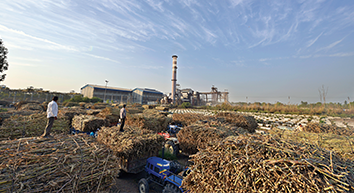The Company is engaged in multiple businesses and there are unique risks associated with each business. The Company follows a well-structured Enterprise Risk Management (ERM) Policy, which requires the organisation to identify the risks associated with each business and to categorise them based on their impact and probability of occurrence – at the business level and at the entity level. Mitigation plans are laid out for each risk along with designation of an owner thereof. It is the endeavour of the Company to continually improve its systems, processes and controls to improve the overall risk profile of the Company.
The ERM policy defines the risk parameters within which the businesses should operate. It helps to build a discipline within the organisation wherein all business decisions are taken after assessing the attendant risks and formulating effective mitigation plans to contain the impact of such risks. Since the Company is engaged in diversified businesses having completely different risk profiles, Risk Management Framework for each business has been devised considering its complexity and uniqueness. Sugar business of the Company is agro-based and is largely dependent on uncontrollable climatic factors and Government regulations and policies, whereas the Engineering business relates to capital goods and infrastructure sectors, which are dependent on the economic growth of the country.
Risk of Business Disruption due to COVID-19
Before dwelling on the normal business risks, it is imperative to evaluate the recent emergent risks as a result of COVID-19. The pandemic has brought about most unprecedented public health and socio-economic crisis in our lifetime across the globe. To check the spread of virus, the Government declared complete lockdown from March 25, 2020 till May 3, 2020 during which period only essential services were permitted to operate. Subsequently, the lockdown was relaxed in phases. Many sectors of the economy had been badly hit due to disruption in activities, lower demand, financial crunch, disruption in supply chain and reduced supply of labour.
The major business of the Company – Sugar along with Cogeneration and Distillery, being essential goods in nature, operated uninterruptedly during the lockdown period with the active support of the State and Central Government in overcoming supply chain challenges. The demand of sugar and ethanol declined temporarily during the lockdown period but these were normalized within a few months. The business operations of engineering business were impacted during the lockdown period due to the closure of the factory/project sites but these resumed normal operations by the middle of May 2020. In the subsequent few months, the activities were normalized but there was some loss of business due to inability of customers to take deliveries, delayed order finalization / booking and restriction to travel and interact physically with customers. The business conditions were largely normailised by the 3rd quarter, but the 2nd wave of the pandemic in the 4th quarter has again slowed down the process. There is some degree of uncertainty on when the full normalcy would return and until then, there would be greater reliance on IT tools to connect with customers and transact business to the extent practicable. Equally importantly, the health and welfare of employees and their families is important and the Company would be focusing on this area, including ensuring vaccination for all. It will help to minimize interruptions to the business.
SUGAR BUSINESS
Sugar business is exposed to significant external risks, which mostly are uncontrollable and thus, it is imperative to optimise the controllable business productivity and efficiencies on a dynamic basis to counteract the impact of such external risks. The internal risks are moderate and are by and large predictable and manageable.
It is the objective of the Company to be amongst the top performers in UP, much above the average, so that it remains less impacted by the cyclicality associated with this industry. During SS 2020-21, the Company has achieved recovery of 11.86% (after adjustment of B-heavy molasses) – 44 basis points higher than the average recovery achieved in Uttar Pradesh.
Some of the key external risks to which the Sugar business is exposed are described herein below:
Risk of over dependence on Government’s policies and support
Risk of sugar production in excess of domestic consumption
The all India production in the SS 2020-21 is expected at ~30.9 million tonnes, which is 12% higher than the previous season and against domestic consumption of ~ 26 million tonnes. With opening sugar inventories of 10.7 million tonnes, excess of production over consumption by 4.9 million tonnes, the sugar inventories may further increase unless the surplus stocks are exported. It will lead to higher inventory holdings, increased working capital requirements, higher finance costs and liquidity constraints.
Mitigation
The Government has been actively promoting export of sugar for the last several years to evacuate surplus sugar and provides subsidy to undertake exports. It has again introduced a scheme for exports up to 6 million tonnes for the SS 2020-21 along with export subsidies. Pursuant to the scheme, the target exports are expected to be achieved and in view of firm international prices, the actual exports may exceed the target by up to one million tonnes, which will be without export subsidies. Thus, the sugar inventories at the end of the SS 2020-21 is expected to decline by around 2 million tonnes, which augurs well for the sugar prices and working capital management.
The Government has been supporting production of Ethanol by using B-heavy molasses and sugarcane juice which results in diversion of sugar. The diversion of sugar is estimated at ~ 2 million tonnes in the SS 2020-21 and will progressive increase as further distillation capacities are set up to achieve Government’s target of 20% Ethanol blending by the year 2025.
Pursuant to such policies, our Company has exported significant sugar in FY 21, equivalent to 22% of the production during the year and produced 56% Ethanol from B-heavy molasses. Consequently, the sugar inventory as on March 31, 2021 is 17% lower than the previous year.
As sugarcane prices are unrealistically high, it may not be feasible to compete in the world market on costs without export subsidies. Hence, diversion of sugar for ethanol production is a useful mechanism to achieve fuel security along with maintaining optimal sugar stocks.
Sugar Price Risk
Risk
The sugar prices have significant impact on the profitability and viability of the sugar mills. In the event, the prices go below the break-even levels, losses may be inflicted which may have material impact on the financial position of the company to manage its operations, including payment of cane dues and to service debts.
Mitigation
There are various mitigations available against this key risk, internally and externally:
- The Government announces monthly quota for sale in the domestic market which ensures meeting demand adequately without any excessive supplies. Resultant, the prices remain range bound and excessive volatility is avoided.
- The Government has prescribed Minimum Selling Price (MSP) of sugar below which sugar mills are not permitted to sell sugar. This mechanism avoids collapse in the sugar prices due to overproduction in the country or temporarily excessive supplies in the market.
- The Company has been focussing on improvement of recoveries as these lead to low cost of production of sugar and enables the sugar mill to tide over market variation in sugar prices and make the sugar operation profitable. The recoveries of our Company have significantly improved over the last few years.
- The Company produces premium quality sugar to increase overall realisation prices, the Company produces refined sugar equivalent to ~40% of its production and also produces pharmaceutical grade sugar which fetch substantial premium over plantation white sugar. Additionally, the Company also sells ~11% of sugar through institutional buyers to maintain quality, avoid overdependence on sugar agents and to enhance overall realization price.
- The sugar business of the Company comprises optimal mix of Cogeneration and distillation and because of diversified revenue streams, it is in a better position to meet and overcome various risks.
Risk of increase in sugarcane price
Risk
The cane price in Uttar Pradesh has remained unchanged for the last four years and it is possible that the cane price may increase in the forthcoming SS 2021-22, also in view of state elections to be held next year. The increase in cane price may have significant impact on the financial position of the Company unless it is compensated by commensurate increase in sugar prices.
Mitigation
It is believed that along with increase in cane price, the Government may also increase MSP of sugar to mitigate its impact on the financials of the sugar industry. If the additional cost is lumped on the industry, it will impact its cane price paying capacity and the purpose of increasing cane price will get defeated.
Risk of Climatic factors:
Risk
The climatic factors, such as, monsoon, flood, drought and crop diseases impact the yield and sugar recovery from cane. Lower yields result in lower cane availability to sugar mills whereas lower sugar recovery leads to higher cost of production.
Mitigation
During the season 20-21, the yields and recoveries in the State of U.P. have declined due to climatic factors and accordingly, sugar production was lower by 12.6 %. However, decline in the sugar production was only 7% for the Company as it performed better than the state average. The impact of climatic factors is moderate in Uttar Pradesh due to large irrigated areas, as compared to other monsoon dependent sugarcane producing States, such as, Maharashtra and Karnataka. Further, the cane staff of the Company are quite vigilant and after the sowing season, they closely monitor the growth of sugarcane and disease infestation so that timely action could be taken to avoid or minimise the damage.

ENGINEERING BUSINESS
The Power Transmission business and Water businesses are in the capital goods and infrastructure sectors and are largely dependent on the industrial and general economic conditions in the country which regulate demand of the products of our Engineering businesses. These businesses are exposed to the following major risks:
Risks
Risk of economic slowdown
Slowdown in the economy results in sluggish demand of the products of the user industries, which in turn has adverse effect on investment spend on capital goods required for capacity creation or modernisation.
Scarcity of funds
The sluggish demand puts financial stress on the industrial companies and in view of stressed financials and risk aversion, the lenders generally subject the projects to stringent diligence before arriving at funding decisions. The user industries are forced to defer their expansion plans in view of delay in funding, resulting in poor off-take of capital goods.
Technology risks
It is extremely vital for the Engineering business to offer technology and benchmark efficiencies at par with the competition and in the event of a significant gap in its offerings as compared to its peers, the customers may not prefer the products of the Company.
Project delays and payment risks
On account of financial problems with customers, including non-achievement of financial closure, the project may get delayed, resulting in credit risks, cost overruns and blockage of working capital.
Mitigations
Power Transmission business (PTB)
PTB has fared well in FY 21, given the scale of challenges and constraints it faced due to Covid-19. Order booking during the year was almost at the same level as last year, which is an indication of normalisation of its business activities. The business model of Gear Business is robust with main verticals being supply of Gear boxes to OEMs and Aftermarket services, including retrofitting and refurbishment business, with a focus to expand export footprints. The Company is working on new areas, such as manufacturing of gear internals to other OEMs under ‘Built-to-Print’ and foray into Defence sector using a range of products which are aligned to ‘Make in India’ initiative. The diversified business model will enable Gear Business to avoid overdependence on few sectors and withstand sector specific cyclicality.
Water business (WBG)
The order book of Water business is healthy and despite its operations getting impacted during the financial year due to COVID-19, it has reported satisfactory results. The order intake had been subdued though, in view of delayed finalization of orders. In view of strong pipeline of projects to be tendered and orders under finalization, substantial orders are expected to be secured in the FY 22 unless the impact of second wave of the pandemic is not prolonged.
The Company has an access to almost all technologies which are required to be deployed in various projects within the range and competence of the Company. The Company does proper diligence on its customers prior to accepting any order, which includes evaluating its financials, ensuring financial closure of the project, credit ratings (if any), track record and market feedback, and continues to closely monitor any financial stress which the customer may be subject to during the execution of the project.
2021 Triveni Engineering, All Rights Reserved

























 Financial Review
Financial Review